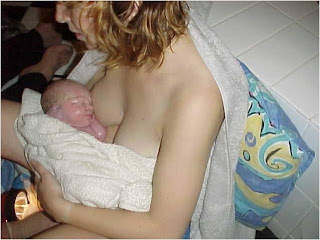Book Review
The Heart in the Womb
Amali Lokugamage, 2011
I have thoroughly enjoyed reading
The Heart in the Womb, which the author, Amali Lokugamage kindly sent to me for review.
This is a wonderful title, 'The Heart in the Womb'. Of course we know that the baby's heart is in the womb, but it seems that Amali Lokugamage has discovered another heart - her own centre of being - within her womb, as her baby developed.
The book has a compelling sub-title 'An exploration of the Roots of Human Love and Social Cohesion'. I am fascinated by Amali's comments about her own development in loving, as her thinking mind surrendered to deeper, hormonally mediated processes. As a midwife, I see evidence of 'roots' of 'human love and social cohesion' being put down in many lives at the time of childbirth. I would love to see a sequel to this account in ?5, 10, and 20 years' time, continuing to explore human love and social cohesion, developing from the roots put down by Amali's son.
This is a very personal account, bringing a significant and seldom-heard perspective to the natural birth/homebirth debate; that of an obstetrician (and a very impressive much more!). "I was prompted to write about this very personal experience because, prior to my pregnancy, I was never fully able to understand why a woman would actively choose to give birth at home, outside of a hospital safety-net."
This is a complex account, weaving together knowledge and comment about Western, Eastern, and alternative maternity and health practices. As I followed Amali along her pregnancy-birthing journey, parts of the story were very familiar to me, and parts were from another place.
I have often pondered the fact that a person who has a great deal of skill in the field of obstetrics can be blind to the basics of physiological birthing. This is a mass-blindness within maternity care providers, and it isn't limited to obstetricians. Midwives who work in birth centres have told me that they couldn't possibly attend home birth because the woman might bleed! That bright red emergency button on the wall represents security! It can be pushed and every available midwife or doctor will rush to the room and provide assistance; the "hospital safety-net" that Amali refers to.
I found the account of the multiple modalities of treatment and preparation that Amali selected very interesting. Interesting because I am, quite openly, a non-believer in many popular alternative medicines that other maternity care providers have embraced, including homeopathy, kinesiology, reiki ... I do not have confidence in acupuncture or acupressure. When I have experienced it, either personally or observing it in a woman, it has not seemed to 'work'! If birth is not an illness, why, I ask, do we need so many treatments?
I do not encourage women to learn meditation or other practices derived from various religions. I encourage them to explore their own understanding of faith, love, and social connection within families. I do not ask women to learn self-hypnosis, although I quickly acknowledge the 'hypnotic' altered state of consciousness that many women enter as they go deeply into their labours. I do not encourage women to undertake childbirth education courses that seem to make them into mini-midwives, trying to understand the minutae of bodily and mind functions, particularly in labour. I have personally come through the Grantly Dick-Read - Lamaze - Leboyer eras, talking about Pavlov's dogs and psychoprophylaxis, and now I don't teach those processes at all. When someone asks me if they should learn patterns of breathing I ask them if they have studied breathing to assist when making love. There's usually a puzzled look. "So why should you learn how to breathe when you are giving birth?"
Amali's account of her multiple advisors, care providers, and guides in her journey towards birth seems to have led her on an action research project. It must have cost a lot! I felt exhausted just following along.
Dear Reader, please forgive me if I seem to have used this review to get on a soap box. As I said, I have thoroughly enjoyed reading
The Heart in the Womb, and I hope you do too.
Copies of this book can be accessed from:
Australia 1
Australia 2
Book Depository - UK but ships free world wide
Amazon
E books
Kindle
Itune
Epub
Thankyou for your comments



